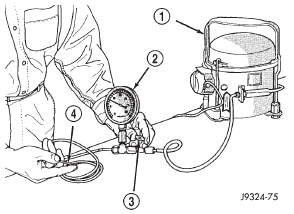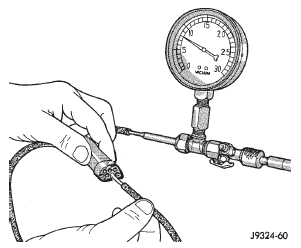Jeep Cherokee (XJ): Low pressure cycling clutch switch. Refrigerant system leaks. Vacuum system
Before performing diagnosis of the low pressure
cycling clutch switch, be certain that the switch is
properly installed on the accumulator fitting. If the
switch is too loose it may not open the Schrader-type
valve in the accumulator fitting, which will prevent
the switch from correctly monitoring the refrigerant
system pressure. Remember that lower ambient temperatures,
below about -1 C (30 F), during cold
weather will open the switch contacts and prevent
compressor operation due to the pressure/temperature
relationship of the refrigerant.
Also verify that the refrigerant system has the correct
refrigerant charge. See Refrigerant System
Charge in the Service Procedures section of this
group for more information.
For circuit descriptions and diagrams, refer to
8W-42 - Air Conditioning/Heater in Group 8W - Wiring
Diagrams.
(1) Disconnect and isolate the battery negative
cable.
(2) Unplug the low pressure cycling clutch switch
wire harness connector from the switch on the accumulator
fitting.
(3) Install a jumper wire between the two cavities
of the low pressure cycling clutch switch wire harness
connector.
(4) Connect a manifold gauge set to the refrigerant
system service ports. See Refrigerant System Service
Equipment and Refrigerant System Service Ports in
the Description and Operation section of this group
for more information.
(5) Connect the battery negative cable.
(6) Place the heater-A/C mode control switch knob
in any A/C position and start the engine.
(7) Check for continuity between the two terminals
of the low pressure cycling clutch switch. There
should be continuity with a suction pressure reading
of 262 kPa (38 psi) or above, and no continuity with a
suction pressure reading of 141 kPa (20.5 psi) or
below. If OK, test and repair the A/C switch sense
circuit as required. If not OK, replace the faulty
switch. WARNING: REVIEW THE WARNINGS AND CAUTIONS
IN THE FRONT OF THIS GROUP BEFORE
LEAK TESTING THE SYSTEM.
If the air conditioning system is not cooling properly,
determine if the refrigerant system is fullycharged.
See A/C Performance in this group for the
procedures. If the refrigerant system is low or empty;
a leak at a refrigerant line, connector fitting, component,
or component seal is likely.
An electronic leak detector designed for R-134a
refrigerant, or a fluorescent R-134a leak detection
dye and a black light are recommended for locating
and confirming refrigerant system leaks. Refer to the
operating instructions supplied by the equipment
manufacturer for proper care and use of this equipment.
An oily residue on or near refrigerant system lines,
connector fittings, components, or component seals
can indicate the general location of a possible refrigerant
leak. However, the exact leak location should
be confirmed with an electronic leak detector prior to
component repair or replacement.
To detect a leak in the refrigerant system with an
electronic leak detector, perform one of the following
procedures: SYSTEM EMPTY (1) Evacuate the refrigerant system. See Refrigerant
System Evacuate in this group for the procedures. (2) Connect and dispense 0.283 kilograms (0.625
pounds or 10 ounces) of R-134a refrigerant into the
evacuated refrigerant system. See Refrigerant System
Charge in this group for the procedures.
(3) Position the vehicle in a wind-free work area.
This will aid in detecting small leaks.
(4) With the engine not running, use a electronic
R-134a leak detector and search for leaks. Because
R-134a refrigerant is heavier than air, the leak detector
probe should be moved slowly along the bottom
side of all refrigerant lines, connector fittings and
components.
(5) To inspect the evaporator coil for leaks, insert
the electronic leak detector probe into the center
instrument panel outlet. Set the blower motor switch
to the lowest speed position, and the mode control
switch in the recirculation mode. SYSTEM LOW (1) Position the vehicle in a wind-free work area.
This will aid in detecting small leaks.
(2) Bring the refrigerant system up to operating
temperature and pressure. This is done by allowing
the engine to run with the air conditioning system
turned on for five minutes.
(3) With the engine not running, use a electronic
R-134a leak detector and search for leaks. Because
R-134a refrigerant is heavier than air, the leak detector
probe should be moved slowly along the bottom
side of all refrigerant lines, connector fittings and
components.
(4) To inspect the evaporator coil for leaks, insert
the electronic leak detector probe into the center
instrument panel outlet. Set the blower motor switch
to the lowest speed position, and the mode control
switch in the recirculation mode. Vacuum control is used to operate the mode doors
in the heater-only and heater-A/C housings. Testing
of the heater-only and heater-A/C mode control
switch operation will determine if the vacuum, electrical,
and mechanical controls are functioning. However,
it is possible that a vacuum control system that
operates perfectly at engine idle (high engine vacuum)
may not function properly at high engine
speeds or loads (low engine vacuum). This can be
caused by leaks in the vacuum system, or a faulty
vacuum check valve.
A vacuum system test will help to identify the
source of poor vacuum system performance or vacuum
system leaks. Before starting this test, stop the
engine and make certain that the problem is not a
disconnected vacuum supply tube at the engine
intake manifold vacuum tap or at the vacuum reservoir.
Use an adjustable vacuum test set (Special Tool
C-3707-B) and a suitable vacuum pump to test the
heater-A/C vacuum control system. With a finger
placed over the end of the vacuum test hose probe
(Fig. 9), adjust the bleed valve on the test set gauge
to obtain a vacuum of exactly 27 kPa (8 in. Hg.).
Release and block the end of the probe several times
to verify that the vacuum reading returns to the
exact 27 kPa (8 in. Hg.) setting. Otherwise, a false
reading will be obtained during testing
1 - VACUUM PUMP TOOL C-4289 VACUUM CHECK VALVE (1) Remove the vacuum check valve. The valve is
located in the vacuum supply tube (black) at the
heater-A/C system vacuum tee.
(2) Connect the test set vacuum supply hose to the
heater-A/C control side of the valve. When connected
to this side of the check valve, no vacuum should
pass and the test set gauge should return to the 27
kPa (8 in. Hg.) setting. If OK, go to Step 3. If not OK,
replace the faulty valve.
(3) Connect the test set vacuum supply hose to the
engine vacuum side of the valve. When connected to
this side of the check valve, vacuum should flow
through the valve without restriction. If not OK,
replace the faulty valve. HEATER-A/C CONTROLS (1) Connect the test set vacuum probe to the heater-
A/C vacuum supply (black) tube at the tee in the
engine compartment. Position the test set gauge so
that it can be viewed from the passenger compartment. (2) Place the heater-A/C mode control switch knob
in each mode position, one position at a time, and
pause after each selection. The test set gauge should
return to the 27 kPa (8 in. Hg.) setting shortly after
each selection is made. If not OK, a component or
vacuum line in the vacuum circuit of the selected
mode has a leak. See the procedure in Locating Vacuum
Leaks.
CAUTION: Do not use lubricant on the switch ports
or in the holes in the plug, as lubricant will ruin the
vacuum valve in the switch. A drop of clean water
in the connector plug holes will help the connector
slide onto the switch ports. LOCATING VACUUM LEAKS WARNING: ON VEHICLES EQUIPPED WITH AIRBAGS,
REFER TO GROUP 8M - PASSIVE
RESTRAINT SYSTEMS BEFORE ATTEMPTING ANY
STEERING WHEEL, STEERING COLUMN, OR
INSTRUMENT PANEL COMPONENT DIAGNOSIS OR
SERVICE. FAILURE TO TAKE THE PROPER PRECAUTIONS
COULD RESULT IN ACCIDENTAL AIRBAG
DEPLOYMENT AND POSSIBLE PERSONAL
INJURY.
(1) Disconnect the vacuum harness connector
behind the glove box and inboard of the glove box
opening on the heater-A/C housing.
(2) Connect the test set vacuum hose probe to each
port in the heater-A/C housing half of the vacuum
harness connector, one port at a time, and pause
after each connection (Fig. 10). The test set gauge
should return to the 27 kPa (8 in. Hg.) setting
shortly after each connection is made. If OK, replace
the faulty heater-A/C control. If not OK, go to Step 3.
(3) Determine the vacuum line color of the vacuum
circuit that is leaking. To determine the vacuum line
colors, refer to the Vacuum Circuits chart (Fig. 11) or
(Fig. 12).
(4) Disconnect and plug the vacuum line from the
component (fitting, actuator, valve, switch, or reservoir)
on the other end of the leaking circuit. Instrument
panel disassembly or removal may be necessary
to gain access to some components. See the service
procedures in this group.
(5) Connect the test set hose or probe to the open
end of the leaking circuit. The test set gauge should
return to the 27 kPa (8 in. Hg.) setting shortly after
each connection is made. If OK, replace the faulty
disconnected component. If not OK, go to Step 6.
(6) To locate a leak in a vacuum line, leave one
end of the line plugged and connect the test set hose
or probe to the other end of the line. Run your fingers
slowly along the line while watching the test set
gauge. The vacuum reading will fluctuate when your
fingers contact the source of the leak. To repair the
vacuum line, cut out the leaking section of the line.
Then, insert the loose ends of the line into a suitable
length of 3 millimeter (0.125 inch) inside diameter
rubber hose.
Low pressure cycling clutch switch
Refrigerant system leaks
Vacuum system

Fig. 9 Adjust Vacuum Test Bleed Valve
2 - VACUUM TEST SET C-3707
3 - BLEED VALVE
4 - PROBE
Fig. 10 Vacuum Circuit Test
Other materials:
Hub bearing and axle shaft. Steering knuckle and ball studs. Differential
Hub bearing and axle shaft
If the axle shaft and hub bearing are being
removed in order to service another component, the
axle shaft and hub bearing can be removed as an
assembly.
REMOVAL
Raise and support the vehicle.
Remove the wheel and tire assembly.
Remove the brak ...


